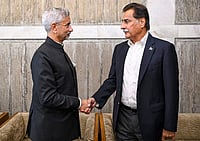“If you do not see what is behind that which you see/ You are as blind as blind can be.” This couplet from the Tamil classic, the Tirukkural, is a perfect key for decoding the strange state of our economy. At a time when the major world powers are seeing spectres of the 2008 global financial meltdown—and emerging market peers like Brazil, Russia and China are in deep trouble—the Indian economy appears to be in relatively fine form. ‘Appears’, of course, is the operative word. For nothing—not the massive domestic market, not the glowing growth numbers, not the thumbs-up sign from foreign investors—can hide a growing sense of disquiet. The stock markets are at their lowest since Narendra Modi took over; the rupee is at a two-year low against the dollar; rural demand is sluggish and agricultural distress is real; export figures are showing a steep fall; residential property prices are frozen; private investment by Indian companies remains stagnant. Unofficial estimates hint that the balance sheets of four out of five commodity companies are stressed. This puts increasing pressure on India’s banking system, already creaking under bad debts. Few sectors are breaking the trend of low growth. Automobiles are one exception, but who knows how long even that will last. Growth in consumer goods is also down, confirming the weakness of demand in rural areas.
How is the government going to get us out of this rut when there’s so little room to boost confidence via major reforms? To be sure, it is serving up the classic formula—forget fiscal deficits, increase spending in infrastructure and agriculture, put money in the hands of people. And recently, the government changed norms for public-private partnerships to lower the risk for private players; it has also reformed defence procurement norms; the Indian Railways has also raised large amounts of funds. The intention is to stoke an infrastructure-led boom. The only problem is that companies and consumers prefer to wait and watch. They are seeing what the government’s growth numbers are failing to hide.


























